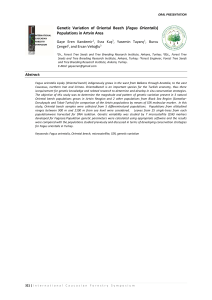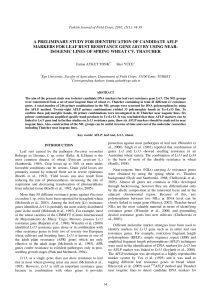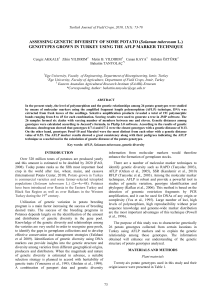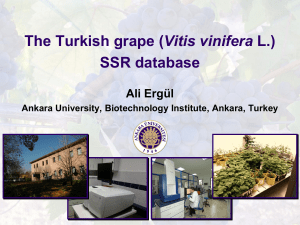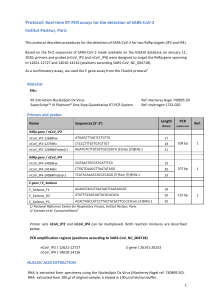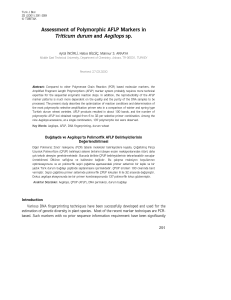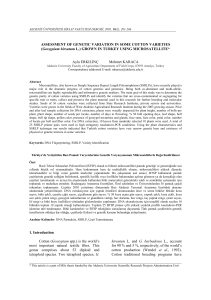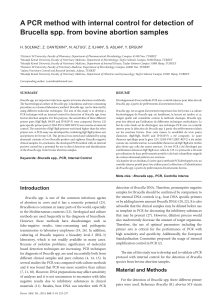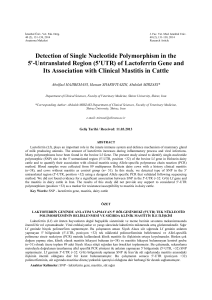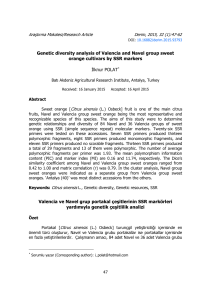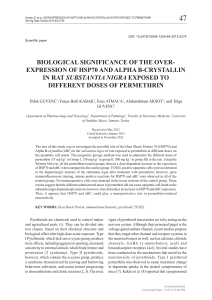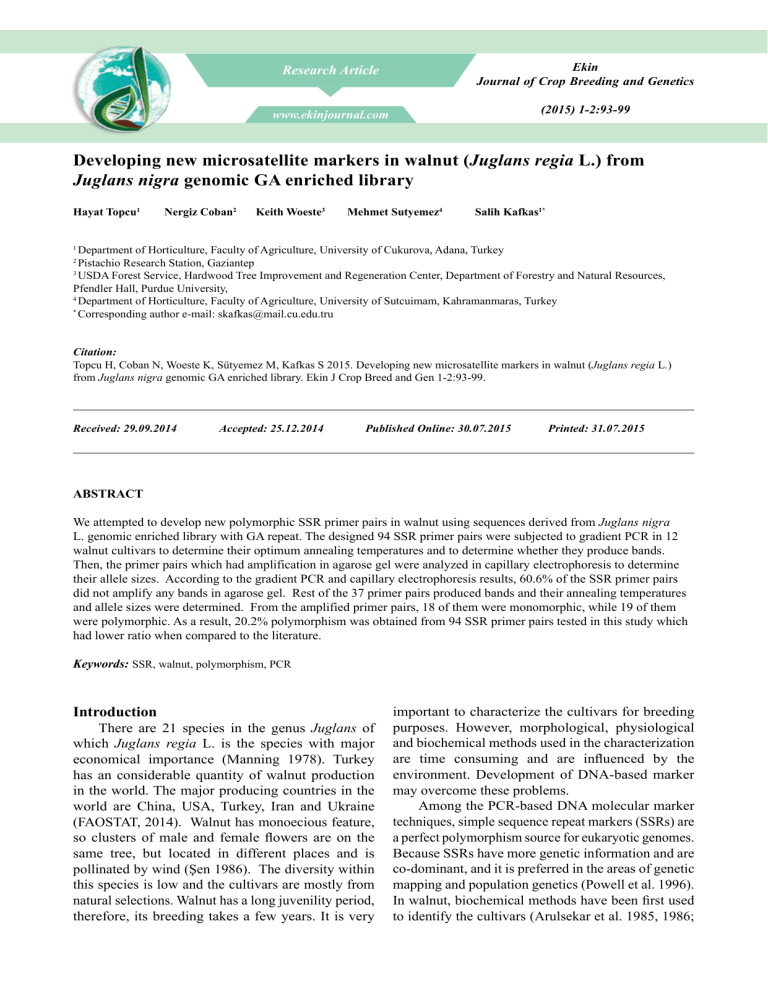
Research Article
Ekin
Journal of Crop Breeding and Genetics
www.ekinjournal.com
(2015) 1-2:93-99
Developing new microsatellite markers in walnut (Juglans regia L.) from
Juglans nigra genomic GA enriched library
Hayat Topcu1
Nergiz Coban2
Keith Woeste3
Mehmet Sutyemez4
Salih Kafkas1*
Department of Horticulture, Faculty of Agriculture, University of Cukurova, Adana, Turkey
Pistachio Research Station, Gaziantep
3
USDA Forest Service, Hardwood Tree Improvement and Regeneration Center, Department of Forestry and Natural Resources,
Pfendler Hall, Purdue University,
4
Department of Horticulture, Faculty of Agriculture, University of Sutcuimam, Kahramanmaras, Turkey
*
Corresponding author e-mail: [email protected]
1
2
Citation:
Topcu H, Coban N, Woeste K, Sütyemez M, Kafkas S 2015. Developing new microsatellite markers in walnut (Juglans regia L.)
from Juglans nigra genomic GA enriched library. Ekin J Crop Breed and Gen 1-2:93-99.
Received: 29.09.2014Accepted: 25.12.2014Published Online: 30.07.2015Printed: 31.07.2015
ABSTRACT
We attempted to develop new polymorphic SSR primer pairs in walnut using sequences derived from Juglans nigra
L. genomic enriched library with GA repeat. The designed 94 SSR primer pairs were subjected to gradient PCR in 12
walnut cultivars to determine their optimum annealing temperatures and to determine whether they produce bands.
Then, the primer pairs which had amplification in agarose gel were analyzed in capillary electrophoresis to determine
their allele sizes. According to the gradient PCR and capillary electrophoresis results, 60.6% of the SSR primer pairs
did not amplify any bands in agarose gel. Rest of the 37 primer pairs produced bands and their annealing temperatures
and allele sizes were determined. From the amplified primer pairs, 18 of them were monomorphic, while 19 of them
were polymorphic. As a result, 20.2% polymorphism was obtained from 94 SSR primer pairs tested in this study which
had lower ratio when compared to the literature.
Keywords: SSR, walnut, polymorphism, PCR
Introduction
There are 21 species in the genus Juglans of
which Juglans regia L. is the species with major
economical importance (Manning 1978). Turkey
has an considerable quantity of walnut production
in the world. The major producing countries in the
world are China, USA, Turkey, Iran and Ukraine
(FAOSTAT, 2014). Walnut has monoecious feature,
so clusters of male and female flowers are on the
same tree, but located in different places and is
pollinated by wind (Şen 1986). The diversity within
this species is low and the cultivars are mostly from
natural selections. Walnut has a long juvenility period,
therefore, its breeding takes a few years. It is very
important to characterize the cultivars for breeding
purposes. However, morphological, physiological
and biochemical methods used in the characterization
are time consuming and are influenced by the
environment. Development of DNA-based marker
may overcome these problems.
Among the PCR-based DNA molecular marker
techniques, simple sequence repeat markers (SSRs) are
a perfect polymorphism source for eukaryotic genomes.
Because SSRs have more genetic information and are
co-dominant, and it is preferred in the areas of genetic
mapping and population genetics (Powell et al. 1996).
In walnut, biochemical methods have been first used
to identify the cultivars (Arulsekar et al. 1985, 1986;
94
Aleta et al. 1990, ; Germain et al. 1993; Malvolti et
al. 1993; Solar et al. 1994; Fornari et al. 2001; Vyas et
al. 2003). Then, RFLP (Fjellstrom et al. 1994), RAPD
(Nicese et al. 1997; Malvolti et al. 1997, 2001; Woeste
et al. 1996), ISSR (Potter et al. 2002), SSR (Woeste et
al. 2002; Dangl et al. 2005; Foroni et al. 2005, 2007;
Victory et al. 2006; Robichaud et al. 2006; Ross-Davis
and Woeste 2008a,b), Pollegioni et al. 2008; Wang et
al. 2008; Hoban et al. 2008, Zhang ve ark. 2010) have
been used in the characterization of genetic resources,
genetic mapping and population genetic studies.
By now 56 SSR primer pairs from J. nigra
genomic DNA, 13 microsatellite primer pairs from
J. cinerae species and 41 EST-SSR primer pairs were
developed from J. regia species (Woeste et al. 2002;
Dangl et al. 2005; Foroni et al. 2005,2007; Victory
et al. 2006; Robichaud et al. 2006; Ross-Davis and
Woeste 2008a,b; Pollegioni et al. 2008, Wang et al.
2008, Zhang ve ark. 2010). So, there are 110 SSR
primer pairs reported so far that can be used in genetic
studies of Juglans species.
Studies on the genetic linkage map construction
in Juglans species are limited and SSRs are powerful
tools in genetic mapping studies because of their
co-dominant nature. SSRs are very useful markers
especially for reference genetic map construction in
a plant species. However, there have to be enough
SSR markers developed to use in the construction
of a reference genetic map in walnut. Because of
the limited number of SSR markers in the literature,
there is no reference map in walnut. Therefore, we
conducted a study to develop new SSRs in walnut.
Materials and methods
Plant material and DNA isolation
As plant materials, ‘Maraş-12’, ‘Kaplan-86’,
‘Chandler’, ‘Franquette’, ‘Serr’, ‘Pedro’, ‘Van4’, ‘Yalova-1’, ‘Bilecik’, ‘Şebin’, ‘Karabodur’ and
‘Maraş-18’ cultivars were used in this study. Ninetyfour SSR primer pairs developed by Dr. Woeste
(Department of Forestry and Natural Resources,
Purdue University) were used.
Genomic DNA was extracted using the
CTAB method of Doyle and Doyle (1987) with
minor modifications (Kafkas et al. 2006). DNA
concentration was determined by gel electrophoresis
(0.8 % agarose gel) and adjusted to 5 ng/µl for SSR
reactions (Figure 1).
SSR analysis
PCR reactions and cycling condition in SSR
analysis were done according to Zaloglu (2008)
by using M13 tailed primer in accordance with
bitki ıslahçıları alt birliği
w w w. b i s a b . o r g . t r
the method developed by Schuelke (2000). M13
universal primer 5‘-TGTAAAACGACGGCCAGT-3’
is attached to the forward primer at the 5’ end and
synthesized. Forward primers became 38-42 baselength. At the same time, 5’ end of M13 primer
of which base sequence is given are synthesized
by labelling with 6-FAM, VIC, NED and PET
fluorescent dyes. Therefore, SSR reaction included
reverse primer, forward primer with M13 primer
tailed at the 5’ end and labelled M13 primer. The
optimum annealing temperatures of SSR primer pair
were determined by gradient PCR by applying six
different temperatures.
12.5 µl PCR amplification reaction includes 75
mM Tris-HCl, pH = 8.8, 20 mM (NH4)2SO4, 2 mM
MgCl2, 0.1% Tween 20, 0,2 mM dNTP, 10 nM
forward primer with an M13 tail at the 5’ end, 200
nM reverse primer, 200 nM universal M13 primer
labelled with one of the following dyes (6-FAM,VIC,
NED, PET), 0.6 unit Taq DNA Polimerase and 10 ng
DNA. Denaturation was 3 min at 94 °C, followed by
30 cycles of 30 s at 94 °C, 45 s at 50-60 °C and 1 min
at 72 °C, and then followed by 10 cycles of 30 s at 94
°C, 45 s at 52 °C and 1 min at 72 °C. Final extension
was included a cycle of 5 min at 72 °C.
Electrophoresis of PCR products
The products of gradient PCR reactions were
stained with etidium bromide in 3%-agarose gel, and
their photos were taken under UV transsimilator. 50
base pair size standard was used to identify DNA band
size in the gel. In order to identify exact allele size of
SSR primer pairs, the electrophoresis of PCR reactions
was done on automatic base sequencing device using
the model of ABI 3130xl having 16 capillary array
(capillary electrophoresis), and the allele sizes were
defined using Genemapper 4.0 software.
Results
Gradient PCR analysis
Ninety-four SSR primer pairs were screened by
using DNAs of ‘Maraş-12’ and ‘Kaplan-86’ cultivars.
An example of the agarose gel image in gradient PCR
is shown in Figure 2.
37 (39.4%) of 94 SSR primer pairs produced
DNA band and, therefore, their annealing temperatures
were determined (Table 1). In the conclusion of the
gradient PCR, the annealing temperatures of the SSR
primer pairs varied from 50°C to 60°C.
Determination of allele sizes and polymorphism
level of the SSR primer pairs
The PCR reactions were done using 37 SSR
(2015) 1-2:93-99
primer pairs which produced band in agarose gel in
12 Juglans regia cultivars and the results are given
in Table 1. According to the results of capillary
electrophoresis (Figure 3), 18 of 37 analyzed primer
pairs produced monomorphic bands, while 19 of them
(51.4%) were polymorphic. So, 60.6% (57 primers)
of 94 SSR primer pairs were out of the evaluation
because of non-amplification in the PCR, and 19.2%
of them (18 primers) were monomorphic and 20.2%
of them (19 primers) were polymorphic.
32 of the 37 primer combinations produced alleles
in single locus, 3 of them had amplification in two loci
and 2 of them amplified in three loci. Sixteen out of
32 SSR primer pairs amplified in single locus were
identified as monomorphic, while the rest of them
were polymorphic. Three SSR primer pairs amplified
two loci and they produced 4 monomorphic and 2
polymorphic loci. Two SSR primer pairs amplified
three loci and they produced 2 monomorphic and 4
polymorphic ones. From 37 evaluated SSR primer
combinations, 44 loci were produced and 22 (50.0%)
of them were monomorphic loci, while 22 (50.0%) of
them produced polymorphic ones. Totally, 124 alleles
were produced from 44 loci and there were an average
of 2.8 alleles per locus.
95
Discussion
The low rate of amplification success which 37
(39.4%) of 94 SSR primer pairs produced DNA band
can be attributed to transferability of the SSRs from
J. nigra to J. regia. Similar results were also reported
earlier (Woeste et al. 2002; Dirlewanger et al. 2002).
In SSR primer development studies in walnut as
reported in scientific literature, the primers have been
developed in J. nigra species as in this study. The
highest number of primer pairs have been developed
by Zhang et al. (2010), followed by this study and
Woeste et al. (2002), respectively. The allele sizes
varied between 100 and 362 base pairs in this study.
The highest rate of average number of allele per primer
was obtained by Victory et al. (2006), whereas the
lowest rates were obtained by Zhang et al. (2010) and
in this study (Table 2).
In conclusion, 94 SSR primer combinations were
designed from genomic DNA library of J. nigra and
tested in J. regia . Consequently, new SSR primers were
developed in this study. They can be used in genetic
characterization, genetic mapping and population
genetic studies in walnut. Moreover, polymorphic SSR
markers together with monomorphic ones should be
tested in the other walnut species in the genus Juglans.
Figure 1. A concentration image of walnut DNA after agarose gel electrophoresis.
Figure 2. A gel image of three SSR primer pairs after gradient PCR.
© Plant Breeders Union of Turkey (BİSAB)
Figure 3. An electropherogram of WGA123 locus in Juglans cultivars obtained from capillary electrophoresis.
96
bitki ıslahçıları alt birliği
w w w. b i s a b . o r g . t r
(2015) 1-2:93-99
97
Table 1. Annealing temperatures, number of locus, allele sizes and allele numbers of the SSR primer combinations.
No Primer Name
Annealing
Fluorescent
Temperature
Dye
Allele Size
Range (bp)
No. of
Alleles
Number of
Locus
Type of marker
1
WGA101
58
PET
120
1
1
Monomorphic
2
WGA104
60
PET
121-139
6
1
Polymorphic
3
WGA108
58
VIC
145-157
2
1
Monomorphic
4
WGA110
54
VIC
103
1
1
Monomorphic
5
WGA111
60
NED
250
1
1
Monomorphic
6
WGA112
56
VIC
106
1
1
Monomorphic
7
WGA116
50
FAM
362
1
1
Monomorphic
8
WGA123
52
FAM
105-271
13
3
Polymorphic
9
WGA125
52
NED
173-253
2
2
Monomorphic
10
WGA126
52
NED
100-350
5
3
Polymorphic
11
WGA127
52
PET
238-281
6
1
Polymorphic
12
WGA131
56
FAM
179-298
5
2
Polymorphic
13
WGA133
50
PET
121-130
3
1
Polymorphic
14
WGA134
52
NED
362
1
1
Monomorphic
15
WGA135
58
NED
355
1
1
Monomorphic
16
WGA136
54
FAM
218-268
9
1
Polymorphic
17
WGA137
54
PET
227
1
1
Monomorphic
18
WGA139
56
NED
171-186
4
1
Polymorphic
19
WGA140
58
FAM
230
1
1
Monomorphic
20
WGA142
54
VIC
243-271
5
1
Polymorphic
21
WGA145
56
VIC
153-161
3
1
Polymorphic
22
WGA148
52
VIC
151-171
3
1
Polymorphic
23
WGA150
60
FAM
199-209
4
1
Polymorphic
24
WGA153
58
FAM
113
1
1
Monomorphic
25
WGA160
54
NED
245
1
1
Monomorphic
26
WGA167
52
FAM
241-253
4
1
Polymorphic
27
WGA168
54
NED
222-259
2
1
Monomorphic
28
WGA169
52
PET
175-188
6
1
Polymorphic
29
WGA171
58
VIC
131-147
5
1
Polymorphic
30
WGA182
60
PET
181-254
3
2
Monomorphic
31
WGA185
54
VIC
262-269
2
1
Polymorphic
32
WGA190
58
PET
135-143
3
1
Polymorphic
33
WGA193
56
FAM
228-267
8
1
Polymorphic
34
WGA195
54
NED
172-198
6
1
Polymorphic
35
WGA196
52
NED
260
1
1
Monomorphic
36
WGA198
52
PET
137-178
2
1
Monomorphic
37
WGA200
54
PET
181
1
1
Monomorphic
© Plant Breeders Union of Turkey (BİSAB)
98
Table 2. Comparison of data in this study with the SSR primer development studies in the literature.
No.
Species
Reference
Number of
primer pair
1
J. nigra
Woeste et al. (2002)
30
150-242
7.3
2
J. nigra
Dangl et al. (2005)
12
143-275
5.2
3
J. nigra
Foroni et al. (2005;2007)
4
120-266
6.0
4
J. nigra
Victory et al. (2006)
4
162-236
23.8
5
J. nigra
Robichaud et al. (2006)
1
208-250
-
6
J. nigra
Ross-Davis and Woeste (2008a)
5
161-164
12.2
7
J. cinerae
Hoban et al. (2008)
13
103-358
13.6
8
J. regia
Zhang et al. (2010)
41
-
3.0
9
J. nigra
In this study
37
100-362
3.4
References
Aleta N, Olarte C, Truco MJ and Arus P (1990)
Identification of walnut cultivars by isozyme
analysis. Acta Hort 284: 91-96.
Arulsekar S, Parfitt DE and McGranahan GH (1985)
Isozyme gene markers in Juglans species
inheritance of Gpi and Aat in J. regia and J.
hindsii. J of Heredity 76: 103-106.
Aruselkar S, McGranahan GH and Parfitt DE (1986)
Inheritance of Phosphoglucomutase and Esterase
isoyzmes in Persian walnut. Jl of Heredity
77:220-221.
Dangl G, Woeste K, Aradhya M, Koehmstedt A, Simon
C, Potter D, Leslie CA and McGranahan G (2005)
Characterization of 14 microsatellite markers for
genetic analysis and cultivar identification of
walnut. J Amer Soc Hort Sci 130: 348-354.
Dirlewanger E, Cosson P, Tavaud M, Aranzana MJ,
Poizat C, Zanetto A, Arús P and Laigret F (2002)
Development of microsatellite markers in peach
(Prunus persica (L) Batsch) and their use in
genetic diversity analysis in peach and sweet
cherry (Prunus avium L.). Theor Appl Genet
105:127-138.
Doyle JJ and Doyle JL (1987) A rapid isolation
procedure for small quantities of fresh leaf tissue.
Phytochem Bull 19: 11-15.
FAOSTAT (2014) http://faostatfaoorg/site/567/defaultaspx
Accessed 14 April 2014.
Fjellstrom RG, Parfitt DE and McGranahan GH (1994)
Genetic relationships and characterization of
Persian walnut (J. regia L.) cultivars using
restriction fragment lenght polymorphisms
(RFLPs ). J Amer Soc Hort Sci 119:833-839.
bitki ıslahçıları alt birliği
w w w. b i s a b . o r g . t r
Allele Size range Average number
(bp)
of alleles
Fornari B, Malvolti ME, Taurchini D and Fineschi S
(2001) Isozyme and organellar DNA analysis of
genetic diversity in natural/naturalised European
and Asiatic walnut (Juglans regia L.) populations.
Acta Hort 544: 167-178.
Foroni I, Rao R, Woeste K and Gallitelli M (2005)
Characterisation of Juglans regia L. with SSR
markers and evaluation of genetic relationships
among cultivars and the ‘Sorrento’ landrace. J of
Hort Sci & Biotech 80:49-53.
Foroni I, Woeste K and Monti LM (2007) Identification
of ‘Sorrento’ walnut using simple sequence
repeats (SSRs). Genet Resour Crop Evol
54:1081-1094.
Germain E, Hanguier I and Monet R (1993)
Identification of eight Juglans spp and
their interspecific hybrids by isoenzimatic
electrophoresis. Acta Hort, 311, 73-85.
Hoban S, Anderson R, Mccleary T, Schlarbaum S and
Romero-Severson J (2008) Thirteen nuclear
microsatellite loci for butternut (Juglans cinerea
L.). Mol Ecol Resour 8:643-646.
Kafkas S (2006) Phylogenetic analysis of the genus
Pistacia by AFLP markers. Plant Syst and Evol
262: 113-124.
Malvolti ME, Paciucci M, Cannata F and Fineschi S
(1993) Genetic variation in Italian populations
of Juglans regia L. Acta Hort 311: 86-94.
Malvolti ME, Spada M, Beritognolo I and Cannata
F (1997) Differentiantion of walnut hybrids
(Juglans nigra L. x Juglans regia L.) through
RAPD markers. Acta Hort 462:43-52.
Malvolti ME, Fornari B, Maccaglia E and Cannata
F (2001) Genetic linkage mapping in an
(2015) 1-2:93-99
intraspesific cross of walnut (Juglans regia L.)
using molecular markers. Acta Hort 544:179-185.
Mannıng WE (1978) The classification within the
Juglandaceae. Ann Mo Bot Gard 65:1058-1087.
Nicese FP, Hormaza JI and Mcgranahan GH (1997)
Characterization of walnut (Juglans regia L.)
cultivars using RAPD. III Int Walnut Congress
Acta Hort 442: 51-63.
Pollegioni P, Woeste K, Major A, Scarascia Mugnozza
G and Malvolti ME (2008) Characterization of
Juglans nigra (L), Juglans regia (L) and Juglans
x intermedia (Carr) by SSR markers: a case study
in Italy. Silvae Genetica, 58:1-2.
Potter D, Gao F, Aiello G, Leslie C and Mcgranahan
GH (2002) Intersimple sequence repeat markers
for fingerprinting and determining genetic
relationships of walnut (Juglans regia) cultivars.
J Amer Soc Hort Sci 127: 75-81.
Powell W, Machray GC and Provan J (1996)
Polymorphism revealed by simple sequence
repeats. Trends in Plant Sci 1:215-221.
Robichaud RL, Glaubitz JC, Rhodes Jr OE and
Woeste K (2006) A robust set of black walnut
microsatellites for parentage and clonal
identification. New Forests 32:179-196.
Ross-Davis A and Woeste KE (2008a) Microsatellite
markers for Juglans cinerea L. and their utility
in other Juglandaceae species. Conserv Genet
9: 465-469.
Ross-Davis A, Huang Z, Mckenna J, Ostry M and
Woeste K (2008b) Morphological and molecular
methods to identify butternut (Juglans cinerea)
and butternut hybrids: relevance to butternut
conservation. Tree Physiology 28:1127-1133.
Schuelke M (2000) An economic method for the
99
fluorescent labeling of PCR fragments. Nat
Biotech 18: 233-234.
Solar A, Smole J and Stampar F (1994) Identification
of walnut cultivars by polen isozymes. Acta Hort
311: 95-100.
Şen SM (1986) Ceviz Yetiştiriciliği. Eser Matbaası,
Samsun, 229 S.
Victory ER, Glaubitz JC, Rhodes-JR OE and Woeste
KE (2006) Genetic homogenety in Juglans
nigra (Juglandaceae) at nuclear microsatellites.
American Journal of Botany 93:118-126.
Vyas D, Sharma SK and Sharma DR (2003) Genetic
structure of walnut genotype using leaf isozymes
as variability measure. Sci Hort 97:141-152.
Wang H, Pei D, Gu RS and Wang BQ (2008) Genetic
diversity and structure of walnut populations in
Central and Southwestern China revealed by
microsatellite markers. J Amer Soc Hort Sci 133:
197-203.
Woeste K, Mcgranahan GH and Bernatzky R (1996)
Randomly amplified polymorphic dna loci from
a walnut backcross [(Juglans hindsii x Juglans
regia) x Juglans regia]. J Amer Soc Hort Sci
121:358- 361.
Woeste K, Burns R, Rhodes O and Michler C (2002)
Thirty polymorphic nuclear microsatellite loci
from black walnut. J.Hered 93:58-60.
Zaloğlu S (2008) Antepfıstığında mikrosatellit
primerlerin geliştirilmesi ve diğer Pistacia
türlerinde kullanılma durumlarının belirlenmesi.
Master Thesis, Cukurova University, Adana.
Zhang R, Zhu A, Wang X, Yu J, Zhang H, Gao J, Cheng
Y and, Deng X (2010) Development of Juglans
regia SSR Markers by Data Mining of the EST
Database. Plant Mol Biol Rep 28:646–653.
© Plant Breeders Union of Turkey (BİSAB)

